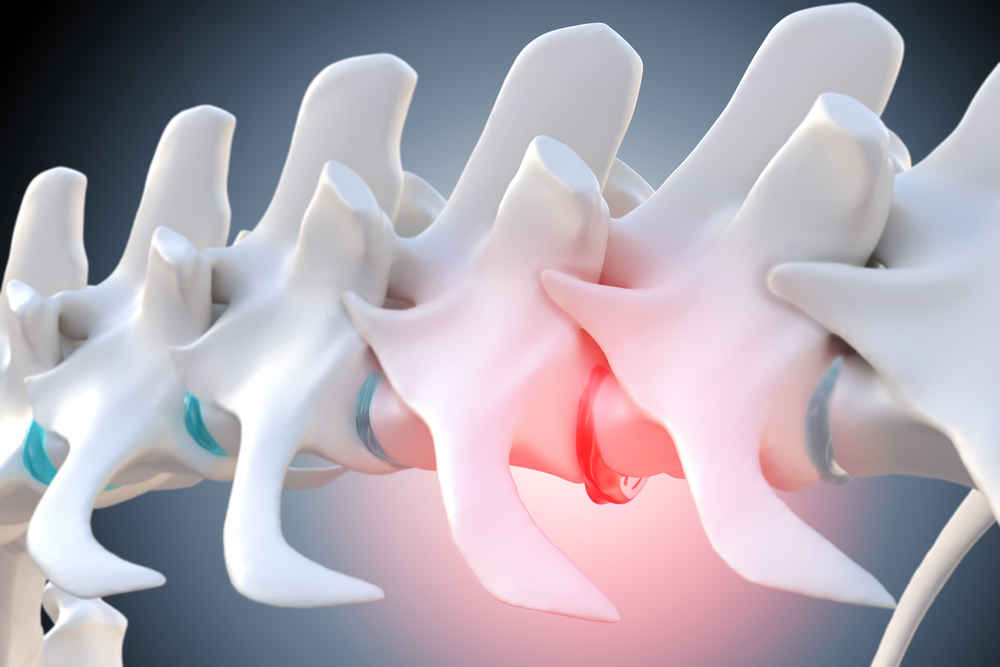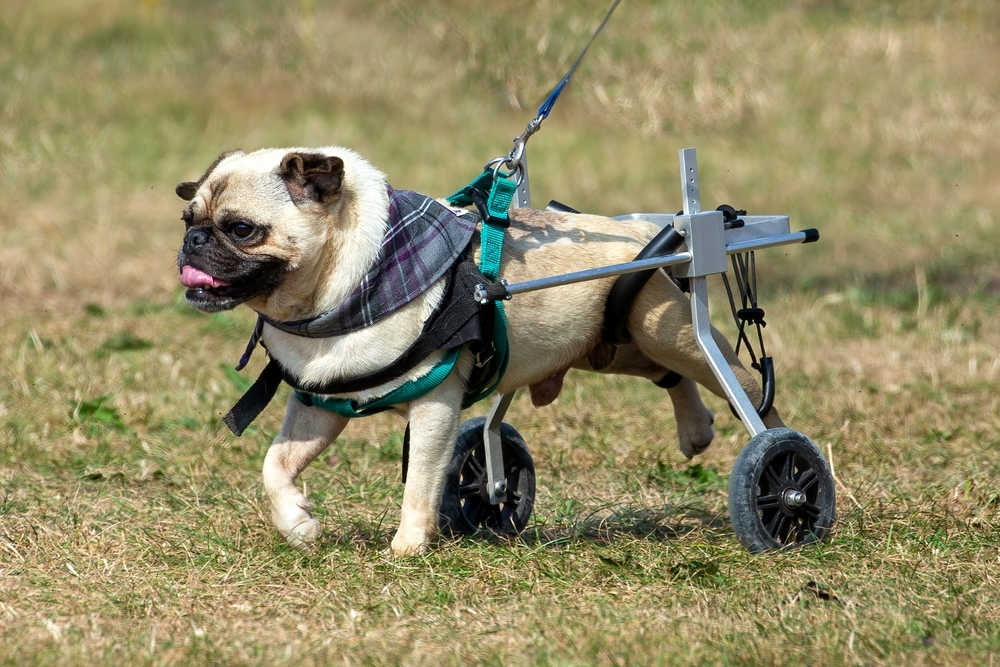
This article was updated on May 1st, 2023

As a veterinarian, I have treated dogs with intervertebral disc disease (IVDD): some of them suddenly could not walk on their own, while others developed pain and weakness after jumping on or off furniture. Many such patients were Dachshunds, although I also saw beagles, poodles, and other breeds with signs of IVDD.
My treatment approach varied depending on the location of the diseased disc and the severity of the symptoms. Although I could often restore normal or near-normal function to many pups, a few of my patients had a reduced quality of life. In this article, we will review IVDD’s impact on a dog’s quality of life and review data on survival rates and life expectancy of dogs with IVDD.

What is the survival rate for IVDD in dogs?

The survival rate for IVDD and the disease’s impact on a dog’s life expectancy depends on the stage of the disease.
- For Stage I, there is a 70-100% survivability with medical treatment and a 95% survival rate with surgery.
- For Stage II, the survival rate with medical intervention is 55-100%, and it is 95% with surgical treatment.
- In Stage III, the survival rate drops to 55-80% for non-surgical and 80-90% for surgical treatment.
- Stage IV dogs have 40-80% survivability with medical intervention and 80-90% with surgery.
- For Stage V, the survival rate is 30% or less if a dog has medical treatment and 50-60% with surgical treatment.
IVDD Prognosis and Life Expectancy by Grade
| Grade | Typical symptoms | Prognosis without surgery & recovery time | Prognosis with surgery & recovery time | Life expectancy |
| 1 | Dog may be walking normally or have stiff gait, signs of mild pain along spine, stiff neck | 70-100% Typically 1-3 weeks depending on severity of signs | 95%. Surgery is usually not required at this stage | Dogs with full recovery will have a normal life expectancy |
| 2 | Moderate pain along neck and back; wobbly gait, knuckling of the paws while standing, weakness, reluctance to move, resistance to jumping or climbing | 55-100% typically, 4-6 weeks depending on severity of signs | 95%; dogs can recover in 1-3 weeks, but some may take longer | Dogs with full recovery will have a normal life expectancy |
| 3 | Moderate to severe pain along neck and back, crying in pain when attempting to walk, knuckling and dragging paws while walking, marked weakness or partial limb paralysis, may require assistance to stand and walk | 55-80% minimum of 4-6 weeks; some dogs will require surgery | 80-90%; typical dogs walking again within 1-3 weeks, but some may take 2 or more months | Dogs with full recovery will have a normal life expectancy; early treatment and rehab is key to recovery |
| 4 | Severe pain along back and neck, unable to rise and walk, feels pain in hind limbs | 40-80% Can walk again without surgery | 80-90%; minimum of 6-8 weeks for recovery | Dogs with full recovery have normal life expectancy; delaying surgery up to 48 hours after injury will not affect outcome |
| 5 | Paralysis of affected limbs, loss of pain sensation, incontinence | 30% or less Walk again without surgery | 50-60% Recovery can vary from 6-8 weeks to 9 or more months | For dogs that don’t recover, life expectancy is greatly shortened and quality of life is limited due to nerve damage, incontinence, pain; and paralysis; your vet may recommend euthanasia |
Survival rates from IVDD diagnosis and prognosis, 5-point grading scale for Dachshunds with IVDD courtesy of Marianne Dorn BVM&S PGCert SART MRCVS.
Can IVDD in dogs be fatal?
In the advanced stages, IVDD can be life-threatening. If the affected disc is in the neck or cervical region, protrusion and compression of the spinal cord can interfere with vital organ systems.
Dogs making a full recovery will have a normal life expectancy
If a dog makes a full recovery, they will have a normal life expectancy for their breed. However, once a pup has IVDD, they are more likely to have a repeat occurrence.
How will IVDD affect my dog’s life? (stages of the disease)
Like arthritis, IVDD is a degenerative disease that progresses with age. Usually, you won’t detect signs until later in life, but some pups develop clinical symptoms as early as 2 years. With IVDD, the disc protrudes from the spinal column, or the core of the disc extrudes through the fibrous layer and hardens.
Regardless of the type of IVDD, the affected disc puts pressure on the spinal cord, causing pain and weakness in the limbs. There are five stages.
Stage I
In stage I IVDD, dogs show minimal signs of pain or discomfort. Your pup may appear to have a stiff neck or gait. Sometimes, dogs show a pain response when you push down on the spine. Usually, these dogs respond favorably and recover quickly with medical treatment.
Stage II
Dogs with stage II IVDD have moderate pain symptoms in the neck area or over the back. Dogs are likely to have a stiff gait and may be reluctant to move or engage in some activities, such as jumping or climbing.
These patients respond well to medical treatment. They can recover quickly if their owners seek immediate care.
Stage III
By stage III, owners notice more obvious signs of the disease. Your pup may cry out in pain or show weakness or have partial paralysis in the limbs.
The treatment method for IVDD at this stage will depend on your veterinarian’s findings when they examine your pooch. Some dogs can still recover with medical treatment and strict cage rest. Others will require surgery.
Stage IV
By stage IV of IVDD, the disc is severely deteriorated and protruding into the spinal cord. Dogs will either have severe pain or cannot walk at this point. However, they usually still have sensory feelings in the affected limbs.
For dogs in stage IV, surgery is required to resolve the symptoms. The prognosis is guarded and will depend on how quickly your dog receives medical support and surgical intervention.
Stage V
With stage V IVDD, dogs have complete paralysis and loss of deep pain sensation in the hind limbs. They’re also often incontinent. Others are unable to urinate at all, which is an emergency.
While some dogs recover with immediate surgical treatment, the prognosis is guarded.
What are the factors impacting life expectancy with IVDD?
The prognosis and life expectancy for a dog with IVDD vary depending on several factors:
- Age of the patient
- The severity of the symptoms and disease stage
- Type of disc disease – injury or degenerative
- Speed of treatment: dogs that receive early diagnosis and treatment are most likely to recover fully.
- Response to treatment
What is the life expectancy without treatment?
If a dog is untreated, they are at risk for disease progression, and this could shorten life expectancy. However, mild cases that recover with cage rest and supportive care may recover as well as treated dogs.
Without intervention, IVDD is, however, likely to get worse. The disc will continue to press on the spinal cord and cause inflammation and pain. Without IVDD treatment, dogs can survive, but they won’t be cured. Depending on the stage of the degenerative disease, it can significantly affect their long-term quality of life:
Dogs with stage I or II: dogs may recover with cage rest and supportive care, but with medical intervention, resolution of the symptoms is more likely.
Dogs with stages III and higher: the lesion advances to a level that requires medical or surgical intervention. Without treatment, your dog’s condition will probably continue to deteriorate and eventually lead to incontinence and complete paralysis. The life expectancy is severely reduced, and your veterinarian may recommend euthanasia.
How quickly does IVDD progress in dogs?
The progression of IVDD in dogs is highly variable and depends on the underlying cause. For some dogs, a sudden movement or injury will cause an already hardened disc to suddenly protrude from the spinal column. Here, dogs can jump from undetectable (Stage I) IVDD to Stage IV or V without warning.
With the other type of IVDD, the degeneration progresses slowly. It may take several years before you notice symptoms in your dog with this form of IVDD.
Diagnosis, Treatment and Medical Management
When a dog has IVDD, the owner may take them to the vet because they notice signs like:
- Changes in gait
- Arching the back
- Crying when someone touches the neck or back
- Limb weakness
- Inability to rise or walk without help
- Pain or difficulty jumping or climbing stairs
- Incontinence
- Limp tail
- Hanging or holding the head lower than normal
- Unexplained shaking or trembling
When the preliminary examination points to IVDD, your veterinarian will perform a neurological examination and take x-rays. By checking for reflexes, motor capabilities, and pain sensation, the doctor can determine the stage of the disease. X-rays will help locate the affected disc or discs and the level of degeneration.
Treatment of IVDD depends on the location of the disc lesion and the severity of the disease.
To determine the best course of treatment, your veterinarian will start with a neurological examination, x-rays, and possibly an MRI or CT scan.
Medical management
Your doctor will probably treat dogs with Stage I or II IVDD medically with pain management and anti-inflammatory drugs to reduce the swelling. Cage rest and restricted exercise for at least 4-6 weeks will also be required. For some dogs in Stage III, medical management is also prescribed.
During treatment, you’ll have regular appointments with your vet to monitor the recovery and update the medical plan. You may not see signs of improvement for a few months. The cost of medical management can range from about $500 to $1000 and may take 3-6 months.
Surgical management
For dogs with stage IV and V disease and some stage III dogs, surgery is necessary. The procedure involves spinal cord decompression by removing the herniated disc material that’s pressing on the spinal cord.
Following surgery, dogs require strict cage rest and pain management for at least 6-8 weeks. Your veterinarian may also recommend physical therapy after the recovery period. The cost of surgical management of IVDD can range from about $4000 to $7000 or more.
How can I make my dog’s life better with IVDD?
When your dog is showing signs of IVDD, the best thing you can do is seek immediate veterinary care. The sooner your dog’s doctor stabilizes and treats your pet, the better the chance of full recovery.
Once a dog has IVDD, they are more likely to have continued back problems and may experience trouble with other discs. However, small breed dogs are more susceptible to IVDD than other dogs, but any canine can suffer from the disease. The breeds with the highest likelihood of getting IVDD include:
- Dogs with long bodies and short legs like the Dachshund, Corgi, and Shih Tzu
- Beagles
- American Cocker Spaniels
- Brachycephalic(smashed face) breeds
Is walking good for dogs with IVDD?
Leash walking on level surfaces is good for dogs with IVDD following the cage-rest part of recovery. Start slow and build up distance over time to help strengthen your dog’s muscles. Always check with your veterinarian before increasing activity. When you walk your dog, use a harness rather than a collar to prevent putting any strain on the neck.
What is the best way to hold a dog with IVDD?
To hold or lift your dog, place a hand under the chest area and cup the other hand around the tail and rump area to fully support the back. Pay close attention and make sure that you keep their back straight.
Can dogs get IVDD more than once?
Yes. Once a dog has IVDD, they are more likely to get it again. Dogs that receive medical treatment for IVDD could have a recurring injury of the affected disc. However, dogs that have surgery can also have IVDD again if another disc ruptures.
Should I put my dog with IVDD down?
The decision to euthanize your dog is one you will have to make with your veterinarian. If your pup doesn’t respond to treatment or continues to show worsening symptoms, you should have a conversation with the doctor. Indications that your dog is suffering and may need to be euthanized include:
- Extreme limb weakness
- Anorexia
- Crying in pain when touched
- Depression and listlessness
- Incontinence
- Inability to move without assistance
How prevalent is IVDD, and which breeds are the most affected?
IVDD occurs in about 2% of the general dog population, but the incidence is higher for some breeds, including:
- Dachshunds
- French bulldogs
- Beagles
- Cocker spaniels
- Lhasa apso
- Maltese
- Miniature poodle
Although large-breed dogs can suffer from IVDD, it’s not as common as it is in smaller breeds.
Disclaimer: This website's content is not a substitute for veterinary care. Always consult with your veterinarian for healthcare decisions. Read More.


I wish I would see this page earlier. It would help me to do a right decision, to hurry, to be more proactive in taking care of my yorkie with IVDD. To late. Good information.
My dog was diagnosed with IVDD but she doesn’t appear to be in pain. She is now completely paralyzed in her hind limbs and losing strength in her front limbs. She knows when she needs to use the bathroom but has issues holding it or moving away from it if she is laying down (otherwise I have her in a sling). She’s 13 and a pit bull mix. She lost her hind limbs use in January but the vet said she had been spinal walking before that. I wonder if she had IVDD or DM. I am considering euthanasia this weekend because she cries from the stuggle to move without my assistance. She’s also losing weight but eating normally. She on Adequan, Medrol, etc.
Oh bless her, I am so sorry to hear about what she has been going through- and you too, of course.
For a larger breed, she is a good age. Given how you have described her mobility, I can imagine things really are a struggle right now.
For her, it is likely confusing and frustrating that she cannot get about or toilet as she would like. Most dogs find it quite upsetting when they soil themselves.
Crying can be due to distress or anxiety, but we do have to consider a pain component- whether orthopaedic or neurological.
Weight loss in spits of a normal appetite can be due to muscle wastage, but there may also be more going on here- such as a tumour.
I cannot recommend anything without seeing her, but I do feel euthanasia is likely in her best interest, as difficult as I know that will be.
“The information on this website is not a substitute for in-person veterinary care. Always seek advice from your veterinarian if you have concerns about your pet’s medical condition.”